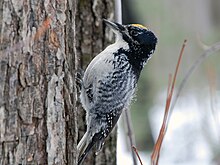American three-toed woodpecker
| Three-toed woodpecker | |
|---|---|

| |
| adult male | |
| Scientific classification | |
| Domain: | Eukaryota |
| Kingdom: | Animalia |
| Phylum: | Chordata |
| Class: | Aves |
| Order: | Piciformes |
| Family: | Picidae |
| Genus: | Picoides |
| Species: | P. dorsalis
|
| Binomial name | |
| Picoides dorsalis Baird, 1858
| |

| |
| American three-toed woodpecker range.[2] A small portion of the Eurasian three-toed woodpecker P. tridactylus range is visible too.[n 1] | |

| |
| Eurasian and American three-toed woodpeckers ranges.[2][n 1] | |
The American three-toed woodpecker (Picoides dorsalis) is a medium-sized
Description
This woodpecker has a length of 21 cm (8.3 in), a wingspan of 38 cm (15 in), and an average weight of 55 g (1.9 oz); its maximum lifespan in the wild is 6 years.[3] It closely resembles the black-backed woodpecker, which is also three-toed. Until recently, it was considered to be the same species as the Eurasian three-toed woodpecker, P. tridactylus.[4] Adults are black on the head, wings and rump, and white from the throat to the belly; the flanks are white with black bars. The back is white with black bars and the tail is black with the white outer feathers barred with black. The adult male has a yellow cap.
Breeding
The breeding habitat is
Movements and foraging
This bird is normally a permanent resident, but northern birds may move south and birds at high elevations may move to lower levels in winter. Three-toed woodpeckers forage on conifers in search of wood-boring beetle larvae or other insects. They may also eat fruit and tree sap. These birds often move into areas with large numbers of insect-infested trees, often following a forest fire or flooding. This bird is likely to give way to the black-backed woodpecker where the two species compete for habitat.
Subspecies
- Picoides dorsalis dorsalis, nominate Western race.
- Picoides dorsalis fasciatus, Rocky Mountain race.
Notes
References
- ^ BirdLife International (2012). "Picoides dorsalis". IUCN Red List of Threatened Species. 2012. Retrieved 26 November 2013.
- ^ a b c BirdLife International and NatureServe (2014) Bird Species Distribution Maps of the World. 2014. Picoides tridactylus. In: IUCN 2014. The IUCN Red List of Threatened Species. Version 2014.3. "The IUCN Red List of Threatened Species". Archived from the original on 2014-06-27. Retrieved 2014-06-27.. Downloaded on 26 May 2015.
- .
- JSTOR 1369173.
- ^ "American Three-toed Woodpecker | Michigan Bird Records Committee". mibirdrecords.com. Retrieved 2023-09-06.
- ^ Burdett, Christopher L.; Niemi, Gerald R. (2002). "Conservation Assessment for Three-toed Woodpecker" (PDF). United States Forest Service: 1–26.
- .
External links
 Media related to Picoides dorsalis at Wikimedia Commons
Media related to Picoides dorsalis at Wikimedia Commons- Photos, videos and observations at Cornell Lab of Ornithologys Birds of the World
- Three-toed woodpecker Information – USGS Patuxent Bird Identification InfoCenter
- American three-toed woodpecker photo gallery at VIREO (Drexel University)

